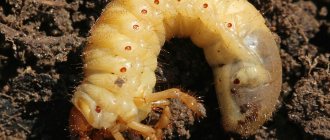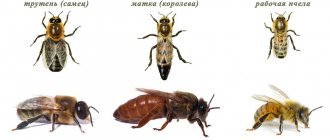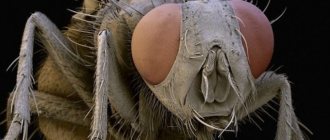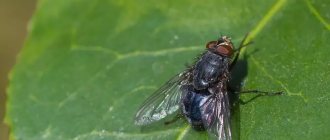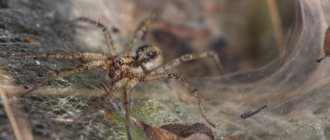- Wild animals
- >>
- Insects
The earwig is a predatory insect with omnivorous feeding habits, which sometimes lead to significant damage to some commercial crops. Most often, they contaminate vegetables by getting inside them. However, they can be useful in some cases due to their predatory habits. The name refers to the legend that it can crawl into a person's ear and gnaw through the eardrum. It is curious that such an explanation is also available in the English-speaking segment. However, such cases have not been recorded.
Origin of the species and description
Photo: Earwig
The earwig survives in a wide range of environments and is a fairly common house insect. Today, the name earwig (in English earwig) is interpreted as referring to the appearance of the hind wings, which have features unique and characteristic of these insects and resemble a human ear in an expanded form. The species name is a specific reference to this feature.
The earliest fossils of earwigs date back to the end of the Triassic period. A total of 70 specimens were found. Some anatomical features of modern earwigs are not found in the earliest fossils. Their claws did not bend completely, like those of modern representatives. Ancient insects looked like modern cockroaches. Their trace was lost in the sediments of the Permian period. Representatives of this group are not found in the Triassic period, when the evolutionary transition from Protelytroptera to earwigs may have occurred.
Video: Earwig
Archidermaptera is thought to be sister to the remaining groups of earwigs, the extinct group Eodermaptera and the living suborder Neodermaptera. The extinct suborders have tarsi with five segments (as opposed to the three found in Neodermaptera), as well as unsegmented cerci. No fossils of Hemimeridae and Arixeniidae are known. Like most other epizootic species there are no fossils, but they are probably no older than the late Tertiary.
Some evidence of early evolutionary history is the structure of the antennal heart, a separate circulatory organ consisting of two ampoules or vesicles that are attached to the frontal cuticle at the bases of the antennae. These features have not been found in other insects. They pump blood through elastic connective tissue rather than muscles.
How to get rid of earwigs in your home
It’s an unpleasant moment if earwigs live in the house, when they crawl into socks, underwear, or hide in clothes.
Safe folk recipes against earwigs
1). They repel aliens with the help of herbs and aromatic oils: they do not like basil, rosemary, thyme, lavender and pyrethrum. Essential oil is dripped into the aroma lamp, and dried herbs are laid out in bunches or in fabric bags.
2). A wet rag or a cut potato acts as a trap. It is worth considering that insects are fleet-footed, so the rag is rolled up without delay and burned or packed in a plastic bag and thrown away. Another trap: a tin can with vegetable oil poured into the bottom.
3). The common earwig does not like the smell of vinegar, so it is necessary to wipe the area where these insects appear. Carefully wipe indoor plants with the solution. Add 50 ml of a 9% solution per 5 liters to the water for washing floors and walls.
4). Boric acid is mixed with the yolk and 1 cm balls are laid out where the “tenants” come. This substance is poisonous to them. Change the bait once a week when it dries out. Sometimes powder is scattered, but in places inaccessible to children and pets.
5). Eliminate moisture.
Chemicals
Chemicals will reliably destroy or drive away terrible insects. But when working with insecticides, personal protective equipment is required. Using aerosols, protect the respiratory tract. After gels and powders, wash your hands thoroughly.
There is no special remedy against earwigs, so they buy those that are designed to combat crawling insects.
In difficult cases, if a massive invasion of insects is visible, or if there is no desire to fight on your own, call an exterminator.
Appearance and features
Photo: What an earwig looks like
Earwigs are brownish-red in color and have elongated bodies ranging from 12 to 15 mm in length. They are equipped with 3 pairs of legs that are yellowish-brown in color. The elongated, flattened brownish body has a shield-shaped front back. The insect has two pairs of wings and thread-like antennae about 12–15 mm long. Adult males vary in body mass and head width. Common earwigs are known for the set of pincers that protrude from their abdomen and are used for protection and in mating rituals.
The forceps show sexual dimorphism, with males being strong, longer and more curved than females. Women's forceps are about 3 mm long, less durable and straight. The European earwig has two antennae, 14 to 15 segments long, which contain many important sensory organs, as well as a fully developed set of wings.
The long, segmented filaments are used during mating, feeding, and self-defense. Females also have a tegmena about 2 mm in length. The hind wings are membranous, wide with lobular veins. The earwig stays almost vertical in flight. When folding its wings together, the insect folds them twice. Despite its rather developed wings, the earwig uses them extremely rarely, preferring to move on its limbs. The legs are of a running type and consist of three segments.
Description of the double tail
Double-tailed
Two-tailed animals are small arthropods from the order of cryptomaxillary hexapods . Their ancestors lived millions of years ago. Two-tailed birds live in tropical climates; out of 800 species, about 30 are found in Russia.
The body length of most species is 2–7 mm . It consists of a head capsule and an abdomen, divided into 11 segments. At the end of the abdomen there are 2 appendages (cerci) . They can be long, thread-like or short, claw-like. Since two-tails do not have eyes, their functions are performed by the cerci.
The mouth is hidden in the head capsule. There are long antennae located in front of the head. On the initial segments of the abdomen there are 3 pairs of jointed limbs.
The body is bi-easted and light in color .
Due to their inconspicuous coloring, small size and hidden lifestyle, they are hardly noticeable. They live in moist soil and humus, in damp fallen leaves. Life expectancy is about a year.
Where does the earwig live?
Photo: Earwig in Russia
Earwigs are native to Europe, East Asia and North Africa. Today they can be found on every continent except Antarctica. The geographic range of the species continues to expand. They have even been found on the island of Guadeloupe in the Pacific Ocean. In Russia, the earwig is seen east to Omsk and in the Urals, and in Kazakhstan, the range extends to the Volga interfluve, south to Ashgabat, including the Kopetdag Mountains. The earwig was introduced to North America in the early twentieth century and is now common across much of the continent.
Fun fact: In North America, the earwig has two related subspecies that are reproductively isolated. Populations in cold climates generally have one clutch per year, producing species A, while populations in warmer climates have two clutches per year, producing species B.
European earwigs are terrestrial organisms that live primarily in temperate climates. They were originally discovered in the Palearctic and are most active when daytime temperatures have minimal fluctuations. The insects are found over a very wide geographic range and at altitudes up to 2824 m. During the day, they prefer places that are dark and damp to hide from predators.
Their habitat includes forests, agricultural and suburban areas. During the mating season, females prefer nutrient-rich habitats as a place to burrow and lay eggs. Hibernating adults can tolerate cool temperatures, but their survival is reduced in poorly drained soils such as clay. To avoid excess moisture, they tend to the south side of the slopes. Sometimes they also occupy the hollow stems of flowers.
Danger and harm to humans
Biologists admit that stories about the mortal danger of this arthropod for people are mere fiction. This insect is not poisonous. If a person falls asleep carefree while lying on the ground, an earwig may accidentally crawl into his ear and get stuck there. But a person should simply consult a doctor who can remove the insect from the auricle.
Although the earwig lives and hunts outdoors, it may accidentally end up in the house, among purchased or picked fruit (these insects like to hide on it during the day), or in a bouquet of flowers. Earwigs love a moist environment, so they may stay in an apartment and choose to live in the bathroom or kitchen.
The earwig's bite is not poisonous. This insect does not attack a person first, but can sting him in self-defense. An earwig can take accidental contact for aggression and sting. The skin in the area of the bite may turn red, but a regular antiseptic will cope with this.
But the bite can be dangerous:
- In children and allergy sufferers, it can provoke a negative reaction in the body.
- The victim can damage the wound by excessive scratching.
- An external infection can enter the wound.
In case of a bite, you can also lubricate the skin around it with vinegar or alcohol. Cover the affected area of skin with a clean cloth. Covering it with a band-aid can lead to undesirable consequences, so it is better to use canvas. To avoid allergic reactions, you can take an antihistamine (such as Claritin).
For summer residents, the earwig can create problems because it destroys vegetable gardens and orchards. Arthropods nibble on dahlias and roses. The earwig can also gnaw the leaves and roots of fruit trees. They also harm potatoes, celery, and corn. Earwigs can cause real damage to garden areas only if there are too many of them.
At the same time, ticks can work as orderlies in summer cottages. They fight aphids and eat the remains of dead insects and fallen fruit. They note that there is no need to worry about excessive damage to trees by these insects if they have enough other food - dead insects. Bivalve larvae can become a disaster for seedlings and root crops.
What does an earwig eat?
Photo: Common earwig
Earwigs are active mainly at night. This insect is an omnivore, feeding on a variety of plant and animal matter. Although the insect's predatory habits are somewhat compensated by eating plant matter, they can sometimes cause significant damage to vegetables, fruits and flowers. Beans, beets, cabbage, celery, cauliflower, cucumber, lettuce, peas, potatoes, rhubarb and tomato are among the vegetable crops that are under attack. Although earwigs are considered scavengers and predators. They feed with their chewing mouthparts. They are known to feed on:
- aphids;
- spiders;
- larvae;
- mites;
- insect eggs.
Their favorite plants are:
- white clover (Trifolium repens);
- medicinal grasshopper (Sisymbrium officinale);
- dahlia (Dahlia).
They also like to eat:
- molasses;
- lichens;
- fruits;
- fungi;
- algae.
These insects prefer to eat meat or sugar rather than natural plant material, although plants are the main natural food source. Earwigs prefer aphids to plant material. Adults eat more insects than young ones. Among the flowers most often injured are dahlias, carnations and zinnias. Damage to ripe fruits such as apple, apricot, peach, plum, pear and strawberry is sometimes reported.
Although earwigs have well-developed wings, they are excessively weak and rarely used. Instead, earwigs use people's clothing, commercial goods such as lumber, ornamental shrubs, and even bundles of newspaper as their primary mode of transport. They often consume vegetables and animal matter in equal proportions.
Diet and habitat of the common earwig
In terms of feeding regime, earwigs are quite polyphagous insects, feeding on both animal and plant foods, consuming living and rotting plants, animal remains, as well as attacking small larvae or adult insects, worms, and spiders. Moreover, for a number of species there is a clear preference for animal food.
The common earwig is widely distributed throughout Europe, the Russian Federation, Ukraine and Kazakhstan. Also artificially introduced into North America and New Zealand.
Features of character and lifestyle
Photo: Earwig insect
Earwigs are nocturnal. They hide during the day in dark, damp places such as rocks, plants, huddles, fruits, flowers and other similar places. They emerge at night to hunt or gather food. They are weak flyers and therefore move mainly by crawling and being carried by humans. Earwigs can be considered either solitary or colonial insects. During the mating season, females live alone, but during other months of the year they tend to gather in very large groups.
Earwigs are considered a subsocial species because they provide parental care to their children. When common earwigs feel threatened, they use their pincers as weapons to defend themselves. Adult earwigs release a pheromone that attracts other earwigs. Nymphs also release pheromones that entice mothers to care for them. The tongs are also used as a means of communication during mating and exhibit threatening behavior.
The nighttime activity of earwigs depends on the weather. Stable temperatures stimulate activity, but extremely high temperatures are discouraged. High relative humidity suppresses movement, while higher wind speeds and greater cloud cover stimulate earwig activity. They produce an aggregation pheromone in their excrement that is attractive to both sexes and nymphs, and secrete quinones as defensive chemicals from abdominal glands.
Ridding the garden of pests
You can get rid of earwigs in the garden without harming the crop in the following ways.
- To free your garden or vegetable garden from woodlice and earwigs, you must first of all put it in order. You should get rid of damp places littered with various waste, as well as compost heaps and fallen trees. After all, this is where pests most often live.
- The fight against earwigs will also be effective when digging deep into the soil in late autumn.
- Earwigs can be killed using a trap. It uses a generously dampened rag, a used tin can or an old watering hose. If you find tweezers under a particular item, you should pour boiling water over them.
- It is effective to poison earwigs with poisons. Fufaon, Intavir or Iskra can be used to spray infected plantings. Biological products such as Lepidocide or Bitoxibacillin also give good results.
- You can also remove earwigs using folk remedies. To do this, many use the method of repelling plants that have insecticidal properties. Wormwood, yarrow, tansy or basil are what earwigs fear. A tincture is made from them, to which washing powder or laundry soap is added. This solution is used to treat damaged plants.
However, not all reviews about tweezers are negative. If you find an insect in your garden or vegetable garden, you should not rush to destroy it. In single quantities the pest does not pose a great threat to plants. And even vice versa: it is a destroyer of caterpillars, spider mites, flies, slugs and aphids. Earwigs should be controlled when their numbers become excessive.
Social structure and reproduction
Photo: Earwig in the garden
Earwigs usually mate in September, after which they can be found underground in burrows. Courtship rituals involving pincers play a large role in the mating process. Males wave their tongs in the air, stroking and grabbing the female. However, forceps are not used in the actual mating process. If the female approves of the male's advances, he turns his abdomen into a mating position and attaches himself to the female. During mating, females move around and feed with the male attached to her abdomen. Fertilization of the eggs occurs inside the female. Sometimes during mating, another male will come and use his tongs to fight off the mating male and take his place.
Fun Fact: Earwigs typically breed once a year from September to January. In late winter or early spring, females lay 30 to 55 eggs in a burrow dug in the soil. The offspring become independent two months after hatching and no longer require parental care. Earwigs reach sexual maturity at 3 months and can breed as early as the following season.
Females overwinter about 5-8 mm underground with their eggs, guarding them and keeping them clean from fungi and other pathogens using their mouths. Males are driven out of the hole in late winter or early spring, and the female lays fertilized eggs. When the larvae hatch after 70 days, the mother provides protection and food by belching.
When they become second instar nymphs, they emerge above ground and find their own food. However, during the day they return to their hole. Nymphs of the third and fourth instars live above ground, where they develop to adulthood. Nymphs are similar to adults, but are lighter in color with smaller wings and antennae. As nymphs progress from one instar to the next, they begin to darken, their wings grow, and their antennae gain more segments. Between each stage of development, the young molt, losing their outer cuticle.
Type of development
Like many representatives of the order of earwigs, according to the type of development it belongs to insects with incomplete metamorphosis.
Typically, the female earwig lays eggs in early autumn, in a nest previously designated for this purpose. The period of complete development of eggs is usually about 6 weeks, during which the female protects them from attacks by enemies. Some time after the larvae hatch from eggs, they are already completely similar to adult individuals, only differing in size. Small individuals do not yet have wings; their gradual growth occurs as they molt.
Read about how earwigs are dangerous to humans.
Natural enemies of the earwig
Photo: What an earwig looks like
The earwig is preyed upon by several species of Diptera, as well as Coleoptera beetles. The main enemies are ground beetles such as Pterostichus vulgaris, Poecilopompilus algidus, forest ground beetles and Calosoma tepidum, as well as flightless beetles (Omus dejeanii). Other predators include toads, snakes, and some birds. The earwig has several different defense mechanisms used to avoid predation. These include using forceps as weapons and using glands found on the abdomen to release chemicals that emit a foul odor and act as a repellent to predators.
The most famous predators of earwigs include:
- ground beetles;
- beetles;
- wasps;
- toads;
- snakes;
- birds.
Earwigs are hosts for a variety of parasitic organisms. They also serve as predators of other insect species such as aphids and some protozoans. Earwigs are important scavengers in the ecosystem, eating almost anything that is edible. Earwigs can help control aphid populations, thereby reducing the number of crops destroyed by pests.
Because earwigs tend to hide in dark, damp places, they often find their way into homes. These insects are practically harmless to humans, but their unpleasant smell and appearance make them undesirable guests in the house. They can also damage fruits and other crops as they feed on them.
In addition, the earwig causes significant damage to crops, flowers and orchards when populations are high. Some of the commercially valuable vegetables it eats include cabbage, cauliflower, celery, lettuce, potatoes, beets and cucumber, among others. They readily consume corn tassels and can damage the crop. They damage young plum and peach trees in early spring when other food is scarce, devouring flowers and leaves at night.
The benefits and harms of insects for human life
To prevent the introduction of larvae, it is necessary to carefully check fertilizers with humus. Often entire populations are formed in this way. Insects are especially dangerous during the dry season.
For prevention, you should do the following:
- It’s good to dig up the area at the end of the harvest season;
- spread wet pieces of fabric around the dacha (they will become a kind of trap);
- place sponges soaked in vinegar in the garden area.
An insect with claws on its tail is not dangerous to humans, but it is a big pest for gardens and vegetable gardens. During an invasion, roses and dahlias suffer more than others - these flowers are the parasite's favorite delicacies. Bee stocks and young crop shoots are also at risk.
The earwig also brings disproportionate benefits to the ecosystem. It eats fallen leaves, dried flowers, insect remains and weeds. An insect with two stings on its tail is an orderly for dachas and vegetable gardens, destroying hazardous waste. But most of all, they help plants that are attacked by aphids and spider mites - these living creatures are a real delicacy for the two-tail.
Title[ | ]
The names of earwigs in various languages mean "pierce the ears" or something similar. There are several assumptions to explain this. Firstly, there is a myth that the earwig crawls into the ear of a sleeping person, pierces the eardrum, reaches the brain and lays eggs there[9]. She feeds on it and grows to the size of a goose egg, while the earwig's victim dies. Of course, an earwig can accidentally get into the ear, but everything that follows is an unconfirmed fiction, “shameless slander,” as the famous Soviet biologist and writer Igor Akimushkin put it. Some people also believe that these insects got their name from their wings, which when folded resemble ears. Others suggest that the similarity of the claws at the end of the earwig's body to the tool used by cosmetologists of the past to pierce women's ears for earrings played a significant role in this.[10][11]

